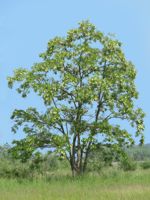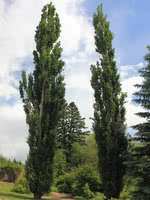Mon-Fri 9am - 5pm Mountain time
Tower Poplar vs Black Locust
Robinia pseudoacacia
Populus x canescens Tower
Black Locust is an attractive tree. Its distinctive leaves are made of about a dozen bright green leaflets. It also notable for its fragrant white flowers, which smell of citrus.
Black Locust can grow in many situations, but prefers dry areas with lots of sun. It is robust and is an excellent choice for establishing shade in dry, open areas.
Important note: Much of the Black Locust is toxic to humans and livestock, including seeds, bark, and leaves.
Tower Poplar is a fast growing, tall columnar tree that closely resembles the Swedish aspen. It produces no fluff, requires minimal maintenance and no pruning. It can tolerate drought and thrives in poor soils. Tower Poplar is most commonly planted in shelterbelts or to line driveways and property lines as a privacy hedge.
Black Locust Quick Facts
Tower Poplar Quick Facts
In row spacing: 0.9 - 1.2 m (3 - 4 ft)

